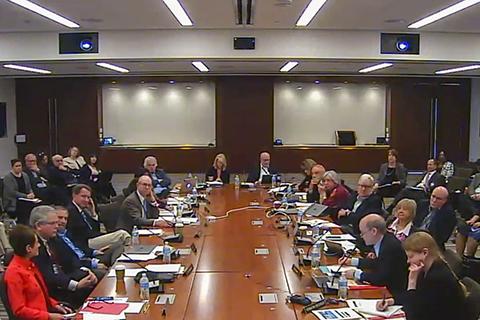
Recent accomplishments and upcoming initiatives at the Frederick National Laboratory (FNL) were the hottest topics at the recent Frederick National Laboratory Advisory Committee (FNLAC) meeting. Here are some excerpts, accompanied by time stamps from the videocast.
00:17:55 – New Cell Therapy Facility to Open at FNL
After a brief introduction by FNLAC Chair Lawrence Marnett, Ph.D., NCI Director Norman Sharpless, M.D., provided a high-level summary of several NCI projects before stating that a new cell therapy facility will be opening at FNL.
“Machines are bought. We’re starting to get the space up-and-running,” he said.
The facility will manufacture T cells for NCI investigators to help overcome industry limitations and address the high demand for such cells. Its operation is likely to be part of a new, NCI-wide cellular immunotherapy strategy for enabling future multi-institutional trials.
01:33:20 – Dmitrovsky: FNL Is “in Transition”
Ethan Dmitrovsky, M.D., delivered his first report as the new laboratory director of FNL, summarizing FNL’s current work and future plans.
Some of the initiatives include partnerships with several Maryland and D.C. academic institutions, as well as a training program with NCI Mexico. FNL and Hood College have also agreed to recreate the annual Hood College Oncogene Science Conference, which Dr. Dmitrovsky described as a famous scientific meeting that was discontinued over 10 years ago.
During the subsequent question-and-answer session, FNLAC member Piermaria Oddone, Ph.D., asked Dr. Dmitrovsky to describe FNL’s level of autonomy in proposing new ideas and programs.
“We’re in transition. We’re not yet at the level of Oak Ridge or Livermore,” Dr. Dmitrovsky replied, adding that he has been meeting with directors of other national laboratories.
“I embrace that challenge,” he said.
02:13:35 – Marnett: National Cryo-EM Facility “Uniquely Frederick”
Sriram Subramaniam, Ph.D., provided the committee with an update about the one-year-old National Cryo-Electron Microscopy Facility (NCEF), which is operated by FNL scientists.
So far, NCEF has completed more than 90 projects and received glowing reviews from its users. Notably, its services are free—typical cryo-EM facilities charge users $1,000–2,000 per day—and its staff doesn’t judge whether a project is “worthy” of the facility’s time and resources.
Subramaniam also described upcoming projects, including a new facility, scheduled to be completed in June 2018 at FNL’s Advanced Technology Research Facility, that will be able to accommodate four Titan Krios microscopes.
Marnett remarked that the NCEF’s “ability to help move the frontier is something, again, that’s uniquely NCI, it’s uniquely Frederick.”
02:15:17 – FNL a Cornerstone of NExT Program and NCI ETCTN
James Doroshow, Ph.D.; Ralph Parchment, Ph.D.; and Jeffrey Moscow, M.D., spoke about the NCI Experimental Therapeutics Program (NExT), the FNL-staffed Pharmacodynamic Biomarker Program, and the NCI Experimental Therapeutics Clinical Trials Network (ETCTN), respectively.
While the three scientists covered diverse facets of NCI’s role in clinical trials and drug development, the crucial support provided by several parts of FNL, especially the Biomarker Program, remained a shared theme.
“The PD Biomarker staff has really been important,” said Moscow.
Moscow added that the program has provided unexpected benefits, such as revealing that two drugs were not effective in patients. That in turn caused the related trials to be discontinued, saving significant time and money.
03:49:20 – ATOM and JDACS4C Gain Momentum
Eric Stahlberg, Ph.D., reported on the Accelerating Therapeutics for Opportunities in Medicine (ATOM) Consortium, which officially launched in October.
According to Stahlberg, the consortium is already making progress. Stage-one research and development began in February, and partner GlaxoSmithKline has provided early data contributions and begun modeling how therapeutic drugs can move and behave in patients’ bodies.
Oddone and Melissa Smith, Ph.D., rounded out the presentations with an update on the Joint Designs for Advanced Computing Solutions for Cancer (JDACS4C), an NCI collaboration with the Department of Energy. Since its start nearly two years ago, the initiative has made strong progress in its three pilot areas.
“They are moving forward very well and forcefully in their independent domains,” said Smith.
Oddone and Smith also offered several suggestions for the future, such as adding more scientific staff at FNL who can support projects at the National Institutes of Health that might benefit from JDACS4C.
05:01:50 – Oddone: FNL Making Exciting Progress
The day concluded with an open discussion about FNL, its progress, and remaining challenges.
“It seems to me that these meetings lately are more exciting than the first meetings, in particular because there are these initiatives,” Oddone said.
Marnett quickly agreed.
“It does sort of position Frederick to be more of a national lab, to be defining frontiers. … There’s a lot of really good science going on,” he said.
The videocast time stamp for the beginning of each presentation can be found below. (Names of FNL employees are in bold.)
00:00:03 – Lawrence Marnett: Opening Remarks
00:03:57 – Norman Sharpless: Report from the NCI Director
00:39:00 – Ethan Dmitrovsky: Frederick National Laboratory: Current Operations and Future Plans
01:38:09 – Sriram Subramaniam: National Cryo-EM Facility (NCEF) Update
02:14:55 – James Doroshow: Overview of the NCI Experimental Therapeutics Program
02:47:09 – Ralph Parchment: Role of Molecular Pharmacodynamics in Both Drug Discovery and Development
03:19:30 – Jeffrey Moscow: NCI’s Early Therapeutics Trials Network: How We Move New Agents into the Clinic
03:49:20 – Eric Stalhberg: Accelerating Therapeutics for Opportunities in Medicine (ATOM) Update
04:21:28 – Piermaria Oddone and Melissa Smith: NCI-DOE Collaborations Working Group Report
05:01:13 – Open Discussion

